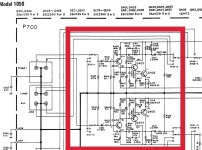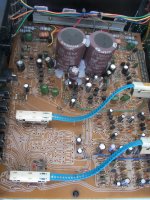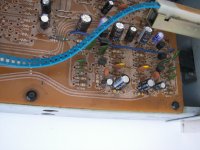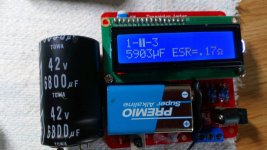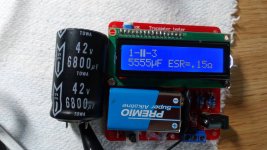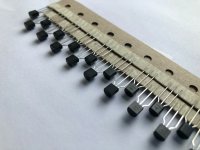Attachments
Last edited:
what is your intent (or why do you think you need to change them)?
is the preamp not working anymore and you are trying to repair it?
is the preamp not working anymore and you are trying to repair it?
Sounds as if you have a bad solder joint somewhere. Did you have noises & pops before recap?
Did you change just the electrolytic caps, or also the forever film caps?
Pop patrol starts with a oscilloscope or sound probe. You start at the back, finding the first place that the pops occur. That is right after the first place where you don't see pops anymore. Then you push on joints and components in that area with a cheap speaker connected to the power amp to see if pops occur when pushing on which part. Use a chopstick or pen with ball point removed to do the pushing. If pushing doesn't work, sometimes circuit cooler spray will. Make note of which component you are treating when a pop occurs. Most likely place is human made solder joints, by you the inexperienced operator. The straw is useful for circuit cooler.
After 1980 transistors & diodes were no more likely than resistors & capacitors to have internal bad connections; After the humans were eliminated from semiconductor processes. Resistors & capacitors have internal welds, and often are REALLY CHEAP in some brands.
The 470k 160k resistors are low hanging fruit if there is hiss. Carbon comp hisses above 100k IMHO, carbon film less, metal film even less. I didn't need a double blind test to hear the hiss reduction when I changed carbon comp plate resistors, 220k, to metal film in my power amp.
Did you change just the electrolytic caps, or also the forever film caps?
Pop patrol starts with a oscilloscope or sound probe. You start at the back, finding the first place that the pops occur. That is right after the first place where you don't see pops anymore. Then you push on joints and components in that area with a cheap speaker connected to the power amp to see if pops occur when pushing on which part. Use a chopstick or pen with ball point removed to do the pushing. If pushing doesn't work, sometimes circuit cooler spray will. Make note of which component you are treating when a pop occurs. Most likely place is human made solder joints, by you the inexperienced operator. The straw is useful for circuit cooler.
After 1980 transistors & diodes were no more likely than resistors & capacitors to have internal bad connections; After the humans were eliminated from semiconductor processes. Resistors & capacitors have internal welds, and often are REALLY CHEAP in some brands.
The 470k 160k resistors are low hanging fruit if there is hiss. Carbon comp hisses above 100k IMHO, carbon film less, metal film even less. I didn't need a double blind test to hear the hiss reduction when I changed carbon comp plate resistors, 220k, to metal film in my power amp.
Last edited:
Phono stage with high hum on right channel, and a liitle hum on left channel. No hum on Tuner/Aux/Tape inputs. The amplifier was full recapped. R431 OK, tested: 198 Ohms. I have to change it because the paint came off. New big caps: 10.000µF. Originals 6800µF.
Attachments
Last edited:
Good luck. Ebay transistors are about 99% fake. Great logos, not even transistors usually. See this thread under parts forum. https://www.diyaudio.com/community/threads/my-transistors-original-or-copy.82638/latest
If you want real ones after checking your find with a DVM, buy from farnell, RS, digikey, mouser, or reischelt. Buy from EU website to avoid customs. UK is no longer in EU.
It is best to trace source of hum as pops on post 4. Other known sources, bad grounds between board and case or in the ground star system. Oxide can block low level sources like hum.
The difference between preamp case ground, preamp power safety ground, preamp analog ground, tone arm ground, turntable case ground, green turntable grounding wire ground are subtle and important to magnetic phono reproduction. Took me about 18 months to get hum out of a kit disco mixer (mm input) from a BIC changer. $15 mixer purchase price, $25 parts, great performance with a lot of attention to detail. I had to pull the mixer power transformer right out of the case, it was stupidly mounted 2.5 cm from the high gain stage. I had to separate the RCA jack rings from the mixer case with rubber O-rings. I had to put a double pi LRCRC filter on the DC supply input of the mixer from the external power supply.
If you want real ones after checking your find with a DVM, buy from farnell, RS, digikey, mouser, or reischelt. Buy from EU website to avoid customs. UK is no longer in EU.
It is best to trace source of hum as pops on post 4. Other known sources, bad grounds between board and case or in the ground star system. Oxide can block low level sources like hum.
The difference between preamp case ground, preamp power safety ground, preamp analog ground, tone arm ground, turntable case ground, green turntable grounding wire ground are subtle and important to magnetic phono reproduction. Took me about 18 months to get hum out of a kit disco mixer (mm input) from a BIC changer. $15 mixer purchase price, $25 parts, great performance with a lot of attention to detail. I had to pull the mixer power transformer right out of the case, it was stupidly mounted 2.5 cm from the high gain stage. I had to separate the RCA jack rings from the mixer case with rubber O-rings. I had to put a double pi LRCRC filter on the DC supply input of the mixer from the external power supply.
Last edited:
Hum with no inputs (no turntable) on both channels. Hum present before replacing new capacitors, only on phono stage. Vinyls on phono sounds very bad, low level volume and distortion. I am going to replace all the six transistors with KSA992 (x2) and KSC1845 (x4), substitutes for 2SA1039 and 2SC2390. Bought on ebay usa.
Please test for noise with both inputs shorted to ground.
Open inputs are undefined, and can be noisy without any fault.
Open inputs are undefined, and can be noisy without any fault.
Bypassed, the input selector is ok. All six transistors are ok too. Perhaps it's the power supply of the amplifier itself (24V), maybe the film/disc capacitors. Phono stage with sound, but low and distorted, very poor audio quality and noisy hum in both channels.
Then if both channels are bad, the power supply is the main suspect until proven otherwise.
What measurements of the power supply have you made?
However, low voltage electrolytic capacitors often go bad after a time. It is entirely possible
that the nfb loop capacitor to ground, the input coupling capacitors, the output coupling capacitors,
and the emitter resistor bypass capacitors, are bad.
What measurements of the power supply have you made?
However, low voltage electrolytic capacitors often go bad after a time. It is entirely possible
that the nfb loop capacitor to ground, the input coupling capacitors, the output coupling capacitors,
and the emitter resistor bypass capacitors, are bad.
Member
Joined 2009
Paid Member
I have a Marantz 1530 and may have a similar phono. It sounds phenomenal with my TT and I'm not messin with it. All the trouble I‘ve had appears to be poor switch contacts (input selector etc.). Not sure if you’ve checked this.
- Home
- Source & Line
- Analogue Source
- Marantz 1050 phono stage
